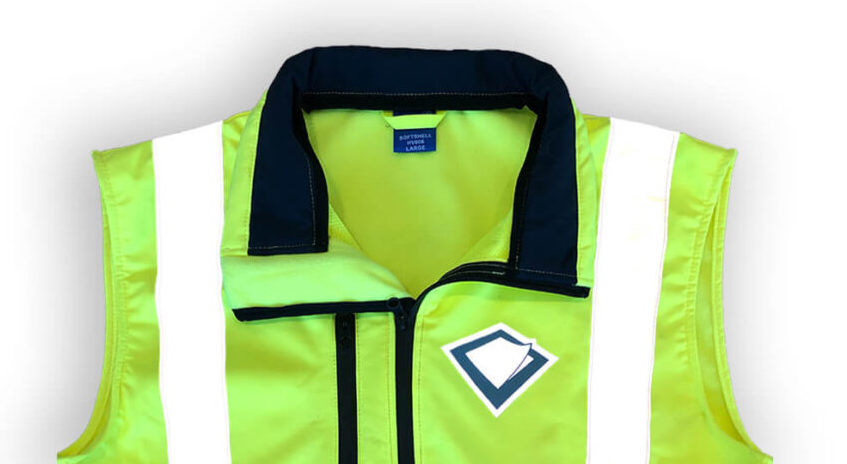If you’re part of a company or at a job that requires reflective workwear and hi-vis printing, you’re at the right place! This guide will help you understand hi-vis printing and the methods involved in branding your garments. The discussion will also include matters surrounding UK laws!
Innotex Transfers produces customer designs for hi-vis every day, so we know the do’s and don’ts of hi-vis garment printing. There are a lot of factors to consider during the process of reflective garment printing.
What is hi-vis?
It’s simply an abbreviation for high visibility. But this refers to the most commonly seen orange and yellow vests, jackets and trousers. Hi-vis garments also come in other colours such as purple, green, red etc. but they aren’t as common. This is because some colours aren’t meeting the necessary guidelines all the time. If you’re part of an industry that work in hazardous conditions, this is really important for your safety! But what makes the material “high-visibility”?
How is hi-vis different to other garments?
Hi-vis workwear adds a luminous effect to the garments so that individuals wearing hi-vis can be seen from a distance. Therefore, anyone can see them in broad daylight and at night, especially drivers! This prevents accidents as it alerts drivers of the presence of individuals long before needed. Hi-vis clothing also has added reflective strips to help others see in the dark!
As you may understand now, hi-vis clothing is very different from standard clothing as it increases awareness of potential hazards. You might also have seen cyclists in hi-vis gear and even the traffic control workers known as “lollipop” men and women. It benefits anyone who wants to be noticed by oncoming traffic so it’s not just for workwear!
EN ISO 20471 guidelines
Here we will cover what EN ISO 20471 is and what significance it has on your company. In order for your hi-vis workwear to be legal, hi-vis printing must follow regulations! Depending on which class you fit in, you’d have a certain guideline to follow. This guide is updated every 5 years; therefore, it’s important to stay up to date with the industry standards. Guidelines are there to make sure industries have a sufficient amount of reflective proportion in their hi-vis garments. Without hi-vis, most drivers wouldn’t be able to see road and construction workers in bad weather or poor lighting, let alone at night.
Here's an overview regarding hi-vis printing...
Let’s run through the current (April 2021) regulations in the UK: There are 3 different classes with specific requirements to meet EN ISO 20471 guidelines. Hi-vis guidelines explain what sections and what visibility is required on workwear so there are less hazards. Let’s go through them one by one. 1) torso, 2) arms and torso, 3) legs, 4) legs and torso, 5) arms, legs and torso. Class 1 is the lowest visibility, which are usually the trousers worn without any other luminous garments. Class 2 is the intermediate visibility and this one is commonly used in the industry. This includes the hi-vis vest and trousers. The highest visibility is Class 3, which isn’t required by most industries. Class 3 is where the entire set comes in but is quite common for road and railroad workers.
Specifications of EN ISO 20471
The table below details the specifications of each class:
| Class 1 | Class 2 | Class 3 | |
| Reflective Tape | 0.10 sqm | 0.13 sqm | 0.20 sqm |
| Fluorescent Material | 0.14 sqm | 0.50 sqm | 0.80 sqm |
Innotex Transfers takes the EN ISO 20471 standards very seriously and are here to help and advise you surrounding the industry guidelines. However, as a business, it is your responsibility to follow the guidelines. Do you need of someone else to do the leg work? Because we have a whole range of EN classified reflective materials for custom ready-to-press transfers!
Printing methods for hi-vis printing
It’s important to understand hi-vis printing methods as you’re responsible for meeting the reflective proportions for your business needs. One main thing to watch out for is where you print on the garment. Maybe you’re printing a logo – make sure it’s printing on the main area rather than the reflective areas.
Dye sublimation compared to hi-vis printing
Have you ever considered dye migration as another method for hi-vis printing? As the material is polyester, it contains the fibres that can absorb the specialised sublimation inks. The drawback with hi-vis is the colour since they’re so vibrant and prone to dye migration. If you print incorrectly, the design will show up fuzzy and blurry! Dye migration is quite handy as the print gets absorbed by the fibre in polyester. 100% polyester is the best for dye sublimation, so it’s definitely worth the read!
Are you more confident about hi-vis printing? We hope so! Click the buttons below and get in contact for anything else you might need!


